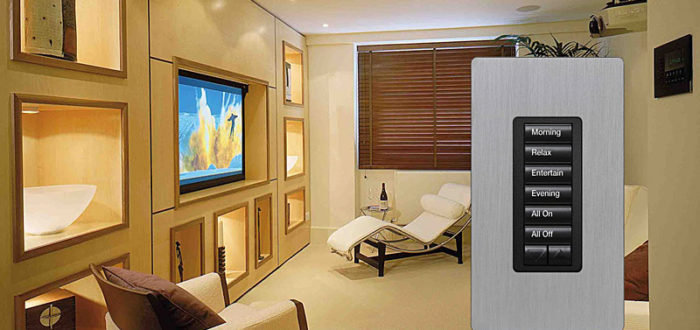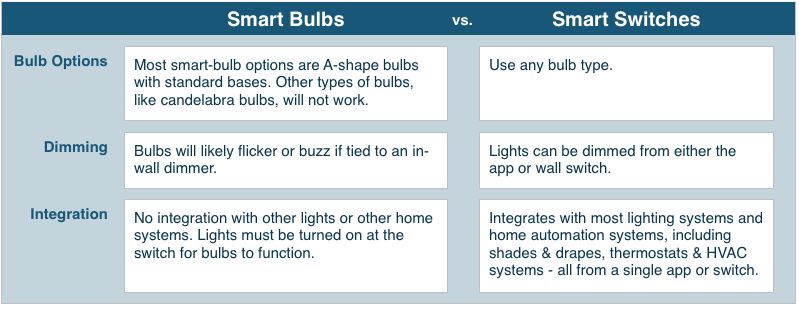
TECHNOLOGY NEWS
Smart Bulb vs. Smart Switch: Which is Smarter?
As the smart home automation industry continues to grow by leaps and bounds, consumers are treated to an increasing selection of innovative products to choose from. However, with all of the new products available to you and more coming out seemingly every day, it can be complicated identifying the ones that represent a truly “smart” investment. If you are currently weighing your options in the booming smart home lighting market and are taken with the idea of using smart bulbs to automate your home, it’s wise to consider the benefits and whether or not an option such as a smart switch potentially makes more sense.
What You Gain By Using Smart Bulbs
Smart bulbs represent a quick and simple way to introduce intelligent lighting to your home. They essentially offer a direct replacement to your existing bulbs that connect via Wi-Fi to a special app that makes it possible to turn them on and off and schedule and control them with a swipe of your finger. Smart bulbs dim without having to install a dimmer, and they come in varieties capable of transitioning into an incredible range of colors to suit the occasion and enhance the mood.
While there’s a lot to love about the modern convenience of being able to control individual lights from virtually anywhere, it doesn’t come without limitations. The following is a list of the top drawbacks of using smart bulbs, along with reasons why smart switches might represent a better fit for you.
Quick Comparison

The Details: Smart Switches vs. Smart Bulbs
Smart bulbs aren’t always a direct replacement
If you only have A-shape light bulbs with E-shape screw-in bases in your home, switching to smart bulbs is a synch. You just screw out the old ones and replace with a smart bulb. But if your current fixtures call for any other type of bulb, options are severely limited and probably unappealing. With a smart switch such as the Lutron RadioRA 2 total home control system, you never have to buy new bulbs, replace existing fixtures, re-wire or part ways with your favorite European manufactured lamp. Smart switches work with whatever bulb you want or currently have. “Period.”
Smart bulbs dim won’t dim when tied to an in-wall dimmer switch
It’s great to instantly add the ability to adjust lights to the exact levels you desire whenever you please without installing a dimmer switch. But if you already have a dimmer switch in place, smart bulbs are often rendered ineffective or suffer from diminished range and light quality. They may even flicker and give off a buzzing sound that has the opposite than intended effect on ambiance and mood. On the other hand, smart switch technology provides precision control over all of the lights in your home, and isn’t affected by existing dimmers. With a smart switch, you can dim your lights from the switch on your wall or from the convenience of an app or remote control device.
Smart bulbs only work when lights are switched on
When the light switches they are wired to are in the on position, smart bulbs provide an exceptional range of control over lighting that’s on par with a smart switch. But if the switch on the wall has been turned off either accidentally or inadvertently, for all intents and purposes you’re disconnected. When you install a smart switch however, you’re actually automating the light switch itself, giving you total control over when it’s on or off. In fact, when you pre-set lighting transitions based on how and when you use the various rooms in your home using a smart switch, it will continue to run on schedule when the physical switch is turned off.
Smart bulbs offer increased control, on a limited basis
Just like with a smart switch, smart bulbs are controllable by an app on your smartphone or Wi-Fi enabled device. However, many of the more affordably priced bulbs can only be controlled individually, or require additional components to operate as a system or on a programmable schedule. When you opt for smart switches over smart bulbs, you’re able to control multiple bulbs wired to the same switch, and you also gain the ability to integrate your entire lighting system with additional home automation technology. So in addition to managing the lights, you can control shades and drapes, thermostats and HVAC systems all from a single, convenient application.
Smart bulbs are pricey when it comes to whole-home automation
If you have the whim to give smart lighting a try and run out to buy a basic smart bulb, it might only set you back $15 or $20. When you replace all the lights in your entire home, choose to purchase more advanced, higher quality products and invest in the necessary technology to control multiple smart bulbs efficiently, it can easily cost you thousands. For those who are sold on modern home automation, having the foresight to go the smart switch route from the start is not only often more economical for whole house control, but it will put you on a path to keep your entire system relevant well into the future.
Final Thoughts on Smart Lighting Options
If you’ve looked into smart lighting and see a bright future, a smart switch such as the Lutron RadioRA 2 represents the next step in upgrading your home automation capabilities. It provides the ability to control lights and other electronics and appliances in your home from a flexible, scalable and reliable wireless component while at the same time instantly improving safety and energy efficiency.
For more information on the benefits and features of the Lutron RadioRA 2 smart switch including details on pricing and installation, get in touch with Mattera Design Inc. today!
